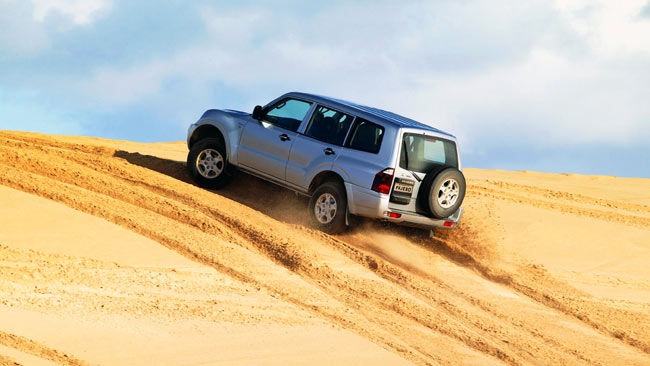
Driving is a great way to begin your exploration of desert country but you must be prepared for any possible situation, especially when driving the less predictable back roads. Bruce Grubbs, author of Desert Sense: Camping, Hiking & Biking in Hot, Dry Climates, offers the following tips to help ensure your comfort and safety.
- On most unmaintained desert roads, you’ll need a vehicle with a higher clearance than a standard car. A car-based SUV or all-wheel drive is better for areas with loose sand. For rocky, steep roads, consider a 4WD truck or possibly a truck-based SUV.
- Give your vehicle a maintenance checkup before you start into the desert. Install high quality tires that won’t break on the first sharp rock you run over. Carry a good spare (not the temporary duty tires that accompany many new cars).
- Bring a tool kit. Load up with tire tools, screwdrivers, pliers, wrenches, extra motor oil, jumper cables, spare fuses, and if possible, extra fan belts and radiator hoses. Carry a fire extinguisher on board, along with a sturdy shovel for digging out a stuck vehicle. Add a tow chain or heavy-duty towrope and a set of sand mats to help gain traction in sandy areas.
- Travel in groups, or even better, in a convoy. In very remote desert areas, it’s advisable to add an extra car to your convoy to carry supplies and be ready as a back-up vehicle.
- Watch out for flooding. During the rainy season, low water crossings can be washed out or unusable. Playas (a large salt flat or dry lake bed that may hold a seasonal lake) and salt flats become wet and soft, or they may flood completely. Summer thunderstorms can even wash out entire roadways.
- Watch out for quicksand. Quicksand is usually found in small, shallow patches, and is a huge danger for cars, because it can’t support the weight.
- Soft, fine, loose sand is also trouble. Scout ahead on foot to see how large the soft section is. If you don’t have another vehicle in your group and a winch or tow chain, be very conservative about attempting to cross. If you get stuck, try rocking the vehicle, but don’t attempt to power your way out.
- Look out for mud especially at river or creek crossings. Some forms of mud can even stop a 4WD vehicle, and it always makes an incredible mess to clean off. It’s best to find an alternative route verses powering through deep mud.
- Approach river and creek crossings with caution. First check the depth and firmness of the crossing on foot. If water is too deep, muddy, or swift to wade, then don’t cross it by vehicle. A vehicle could easily be swept away in such conditions.
- Deep ruts and high centers are common features of unmaintained desert roads. The ridge can be so high that the undercarriage of the vehicle scrapes or hangs up, which can do a lot of damage and get you severely stuck.
- Rocks are a common hazard on desert roads. Drive around them, or get out and move them off the road if necessary. Know where your vehicle has its highest clearance.
- Before you start down a hill, assess whether your vehicle can make it back to the top if necessary (you may run into a spot ahead that is impassable and be forced to turn back the way you came).
- Don’t leave the road and travel cross-country unless it’s an emergency. Tracks left by one single vehicle can last for decades in the desert and where one vehicle goes, many more will be tempted to follow.
- Drive slowly; you’ll gain time to negotiate around dangerous obstacles, and you will do less damage to the roadway and the desert environment.
- Source: Mountaineersbook
